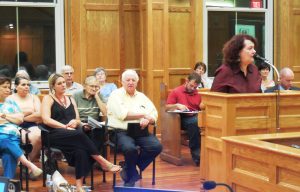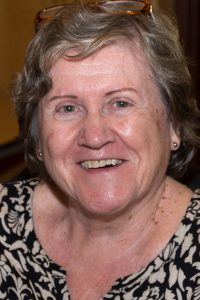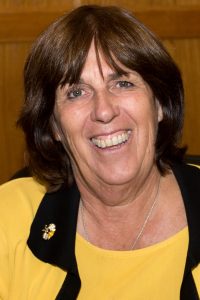WESTFIELD – The City Council allowed more than one and a half hours for the public hearing on the proposed zoning change for Baystate Noble Hospital on Thursday evening. President pro temp Mary O’Connell presided as city councilors, neighbors, city and hospital officials all weighed in on the pros and cons of the changes.
Ward 2 Councilor Ralph J. Figy, the petitioner for the zoning change began by thanking the public for coming out for the second public hearing in one week, and sacrificing personal time with families. He called the public hearing on Tuesday with the Planning Board “very productive,” and started by proposing several changes, the first being to change the name from a Medical Services District to a Hospital Zone, which he thought would alleviate some concerns.
Figy also noted Planning Board chair Philip McEwan’s concern about setback footage of 20 feet in the ordinance, and recommended changing the language to state that footage would be increased by the permitting board. He also took McEwan’s suggestion to change no parking within 20 feet of street line to lot line.
“Based on that, it shows that it’s a process. I intend to be open-minded. I know the citizens and hospital can strike a compromise,” Figy said. He said currently the hospital is a non-conforming use in a residential zone, and the intent is to change the vetting or approval. He said with the Zoning Board of Appeals, the current permitting board, all three must vote in favor of a change. Figy said the Planning Board is the more appropriate body for the hospital to go before.
City Councilors then had an opportunity to question Figy about specifics in the proposal. Ward 1 Councilor Mary Ann Babinski asked if there would be an opportunity for changes. Figy said language could be put in requiring special permits for items of concern.
At-large Councilor Stephen Dondley asked if the hospital would be required to change the current setback, which is less than twenty feet. While Figy was uncertain, At-large Councilor Dave Flaherty suggested that the hospital might be grandfathered in on existing structures.
Flaherty also asked about other businesses applying for the zoning change because requirements are softer. “Once we have a zone on record, other people can transfer property,” he said.
“My feeling is this is a spot zone specifically designed by boundaries,” Figy responded. Allie wondered whether changing it to a hospital zone would limit it to a hospital. Flaherty said there’s nothing that says it can’t be used for other businesses, and added that should be kept in mind during the review in sub-committee.
O’Connell opened up the public hearing to questions of fact. Rob Levesque of R. Levesque Associates introduced himself as the land use consultant for the hospital. He said there has been one neighborhood meeting, and he has also communicated directly with some neighbors about their concerns.
Levesque also said the hospital and he were in agreement with the name change to Hospital Zone. He added there is no intention of putting in a parking garage, and medical offices and clinics listed would be within the hospital itself, as would rehabilitation facilities, which are all included as permitted uses on the zoning change.
“We believe that we can tighten this up,” Levesque said. He also said there is no intention to creep down Court Street and West Silver Street, other than the neighboring house on West Silver that the hospital had already been looking to acquire to expand parking.
Speaking for the proposal, Tina Gorham, director of the Council on Aging, said the COA had long assumed that the majority of their seniors use Noble Hospital. Recently, the COA staff conducted a survey of all seniors who use the building for various purposes during a one week period.
The survey asked two questions, how old was the respondent, and whether he or she had used services at Baystate Noble within the previous two years. Of 296 seniors ages 60 to over 90, on average 75.5% had utilized the services of the hospital, Gorham said.
“We have a great asset in town in Baystate Noble,” said resident Bernie Rosenblum, adding that if they’re going to increase services, they would be a bigger asset to the town, providing more jobs in the fast growing field of health care.
Brookline Ave. resident Susan Figy called Baystate Noble a good neighbor. She said as a realtor, she feels they enhance her property value. She also said that many people who go to visit patients can’t find parking, and more parking is needed.
City advancement officer Joe Mitchell said that at 950 employees, Baystate Noble is the biggest employer in the city, when visiting nurses and urgent care staff are added in.
Baystate Noble president and CEO Ronald Bryant built on Mitchell’s comments, noting that the hospital has created over 75 new jobs in physician practices over the last couple of years. He also spoke of its $165 million economic impact and the $2.8 million spent annually in free care, which he called a legacy that Noble left in his will to take care of patients regardless of their ability to pay.
Bryant also said that per square foot per patient, the Emergency Department is one of the smallest in the state, and that the hospital is desperately in need of single rooms. “There is no other option but to upgrade the facility,” Bryant said. “Most importantly, we’ll continue to save lives,” he added.
“I’m all for a sort of zoning change for the hospital,” said resident Ed Watson of Chestnut St., acknowledging that a new emergency department is needed. He said a few years ago, he started a flight school at Barnes Municipal Airport, and had to go to the City Council, into sub-committees and back to the City Council for approval. “I’m having a real hard time as to why this city would give up control on whatever the hospital wants to build,” he said.
Sensing a change in the direction of the comments, O’Connell asked if there was anybody else who wanted to speak for the hospital. Mill Street resident Lynn Boscher, who called himself a 45-year resident, former member and chair of the Planning Board, Zoning Board of Appeals and City Council, asked the council to continue the public hearing.
“I urge you not to close the hearing tonight, but it keep it open as it goes to L&O.” He said the proposal was barely a page, whereas most are several pages. “It needs more meat in this,” Boscher said.
Speaking against the proposal were several residents who spoke up at the public hearing before the Planning Board, as well as several new voices.
“I love this neighborhood and want to protect it, now and in the future,” said Bridget Matthews-Kane. She said she liked calling it a Hospital Zone better than a Medical Services District, but she is also concerned about zone creepage.
Matthews-Kane said her main issue is whether with a site plan review, the Planning Board will have the power to deny changes in uses available by right in the ordinance. “I hope the hearing will stay open,” she said, adding that some issues, such as wetlands and historical preservation haven’t even been discussed.
Court Street resident Bengt Schneider said he wasn’t principally opposed to hospital improvements, but they had to be balanced with the neighborhood. He suggested striking medical or dental offices, clinics and associated services and laboratories; and nursing homes, social service and rehabilitation centers as permitted uses.
He requested setbacks be extended to 50 feet, and new buildings to not exceed the height of existing buildings. He also noted there is no language on environmental impact in the proposal, or on lighting. He said construction and planning should minimize the impact on property values in the neighborhood.
Flaherty asked Matthews-Kane whether she would prefer having the City Council, an elected board, approve special permits, as opposed to the appointed Planning Board. Both she and Schneider responded that their preference would be the City Council.
Ward 3 Councilor Andrew K. Surprise said the regulations in Holyoke call for special permits for its hospital to go before the City Council for approval.
“Most important to me is the fear of not being able to say no on that property, and the fear of future development. I live right across the street,” said Court Street resident Karen Pighetti. She agreed with special permits going before the City Council. “Lastly, I have a concern about enforcement and accountability. When things are written into a zone, who holds them accountable,” she asked.
Resident Holly Robbins, who said she was born at Noble, said when she bought her house she was told not to worry about expansion of the professional building or parking lot, which were hidden by 50 fir trees. She said the fir trees are all gone, and what was supposed to be a temporary exit from the parking lot to Court Street became permanent.
Robbins said she would like to address the subcommittee meeting, and show them pictures of the changes over the years. ”Let’s try to find a way to make Noble Hospital great,” she said.
After more discussion, Figy moved to keep the public hearing open, and send the matter to the Legislative & Ordinance Committee. Surprise amended the motion to also send it to Zoning, Planning and Development.
“Once we make the final version, I have no objection to send it to ZPD,” said Figy, adding that before then it would “muddy the waters.”
O’Connell deferred to ZPD chair Dondley, who suggested a joint meeting between the two sub-committees. The motion was made, and the zone change referred to a joint sub-committee meeting.




